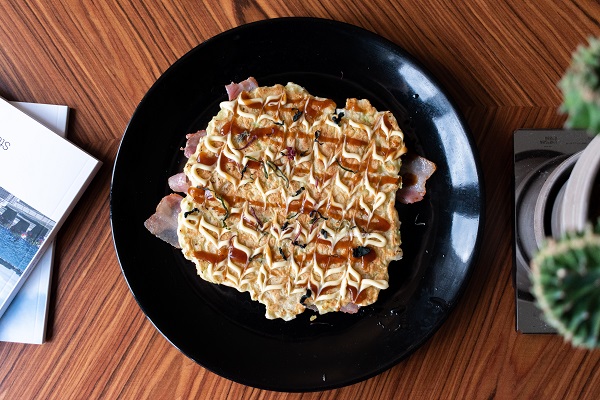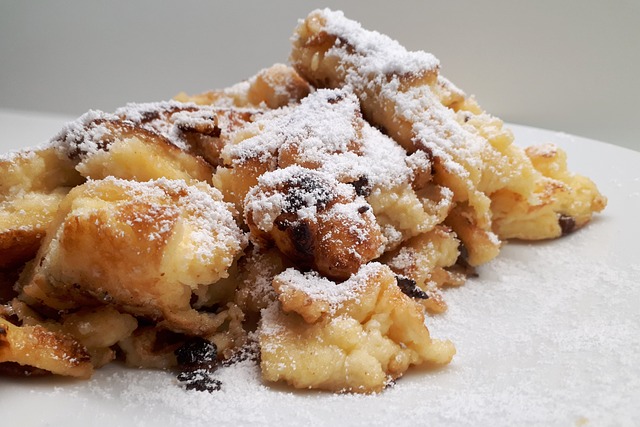
How are you celebrating Shrove Tuesday this year? For many of us, it’ll most likely be with thin crepe-style pancakes or with the thick, fluffy American-style option.
These aren’t the only two choices, though. Countries across the globe have their own take on the pancake: a combination of flour, egg and a whole host of other ingredients, fillings and toppings. If you’re looking for something new to try this Pancake Day, here are 10 global recipes for pancakes you may not have considered…
1. Okonomiyaki (Japan)
These savoury Japanese pancakes (pictured above) consist of flour, eggs and water at their simplest – but they’re often far more elaborate. Many contain shredded cabbage, and some will use dashi (stock) instead of water to add a greater depth of flavour.
Okonomiyaki is a great way to use up leftover vegetables languishing in your fridge, and you can add basically whatever fillings you want. Different regions of Japan prepare their okonomiyaki differently, and the dish’s name literally translates as “as you like it”.
Try this recipe from Wandercooks.
2. Raggmunk (Sweden)
In Sweden, the potato pancakes known as Raggmunk are the comfort food of choice for many. Made with grated potato, flour, milk and egg, they’re traditionally served with fried salted pork belly (use thick-cut bacon if you can’t find it) and sweetened lingonberries (use IKEA lingonberry jam as a substitute!)
You’ll find a Raggmunk recipe here.
3. Cachapas (Venezuela)
If you like your pancakes cheesy, then you’ll love this Venezuelan recipe, popular at the country’s roadside food stands. The batter contains fresh corn kernels and maize flour, as well as eggs, milk, salt, melted butter and sugar. Once cooked, cachapas are filled with queso de mano cheese (use mozzarella as an alternative) and folded in half before serving.
Here’s a cachapas recipe from Curious Cuisiniere.
4. Farinata (Italy)
Hailing from Liguria, the name of these Italian pancakes translates simply as “made with flour”. It’s chickpea flour that’s the star of the show here – and when combined with olive oil, water, rosemary, salt and pepper, it makes for a rustic recipe that’s best served hot.
Try it yourself, thanks to Great Italian Chefs.
5. Injera (Ethiopia)
Teff flour is slowly becoming more popular here…but in Ethiopia, it’s a staple. They use it to make the spongy pancake-like flat breads known as injera, but because of the cost of teff flour they’ll often add wheat or barley flour into the mix.
The teff flour is mixed with water and left to ferment before being poured onto a griddle and cooked. Much like crumpets, the bottom is smooth while the top is full of holes, making it the perfect vessel to tear up and scoop up stews and salads.
Here’s an injera recipe from Daring Gourmet.
6. Kaiserschmarrn (Austria)
Translating as “Emperor’s mess”, Kaiserschmarrn was a favourite dessert of Franz Joseph I, after whom it was named. It uses eggs, flour, butter, sugar, salt and milk for the batter, which is fried on one side in butter before rum-soaked raisins are used to stud the top. After flipping and cooking the other side, the pancake is torn into pieces, sprinkled with icing sugar and served with fruit sauce or compote.
Plated Cravings explains how to make Kaiserschmarrn here.

7. Apam Balik (Malaysia)
Onto the sweet recipes, starting with this thick and fluffy treat from Malaysia. It’s made with flour, milk (sometimes coconut milk), eggs, sugar, baking soda and water, creating a fluffy pancake that’s topped with a combination of crushed roasted peanuts, sweetcorn kernels and sugar before being folded and served.
Now, you’ll find all sorts of other fillings in addition to the classic – including cheese or chocolate sprinkles.
El Mundo Eats have an apam balik recipe here.
8. Msemen (Morocco)
Msemen may be a controversial addition to this list, as they contain no eggs! Combining flour, semolina, oil, water, yeast, salt, sugar and butter, the balls of dough are rolled out before being folded into squares, giving them a degree of lamination.
Msemen are often served in the morning or at teatime, dipped in a combination of honey and melted butter.
Try msemen for yourself with this Taste of Maroc recipe.
9. Pannukakku (Finland)
The Finnish pannukakku is a bit different to most on this list as it’s cooked in the oven, rather than on the hob. This makes it a great choice for Pancake Day if you don’t want to be spending ages tossing pancakes: instead, make one of these and serve it up in slices.
It looks a little like a toad in the hole when it comes out of the oven: crisp around the edges, gooey in the middle. The pancake itself is vanilla-spiked, but is often served as a breakfast dish or sweet treat with jam, whipped cream, sugar or maple syrup.
Here’s a pannukakku recipe from Her Finland.
10. Tiganites (Greece)
Greek tiganites contain flour, yeast, olive oil, sugar, salt and water – although you’ll sometimes find versions that contain eggs, too. While they can be served sweet or savoury, it’s the former that’s the most popular: try them drizzled with honey and sprinkled with nuts and cinnamon.
Dimitra’s Dishes has a great tiganites recipe here.
